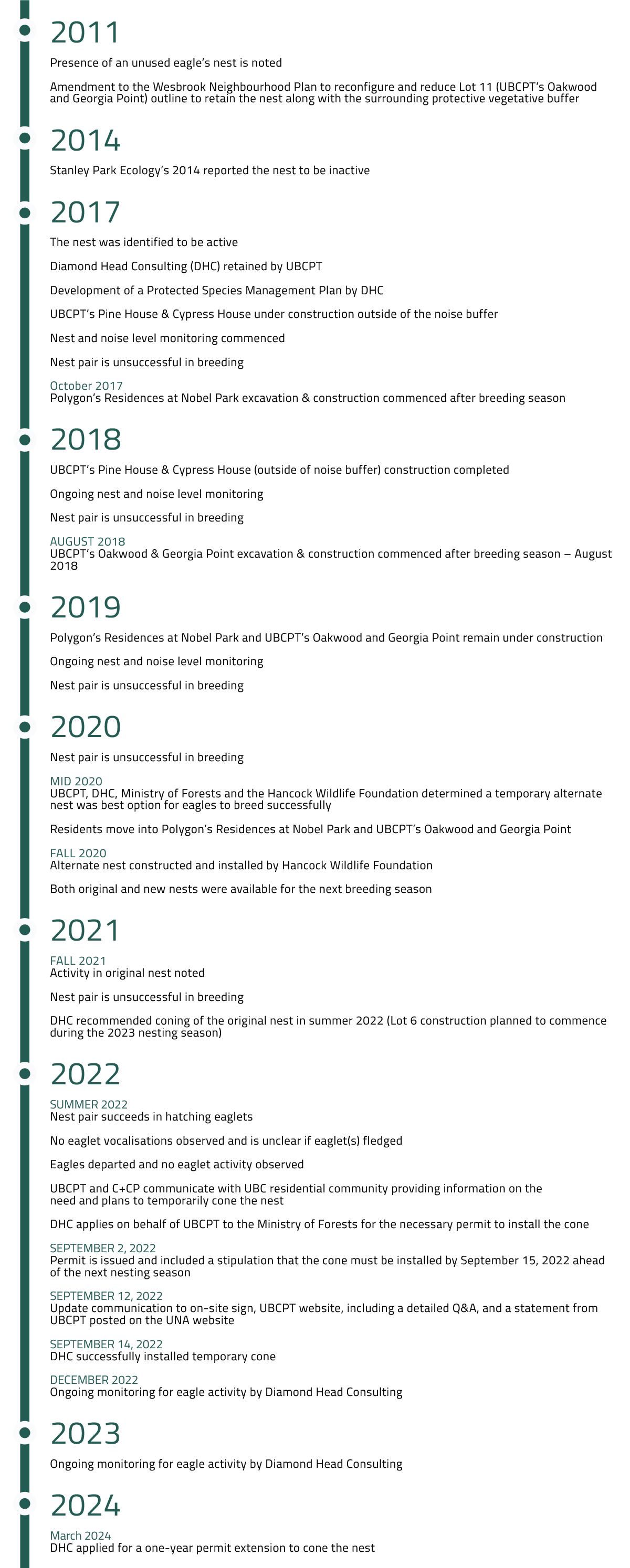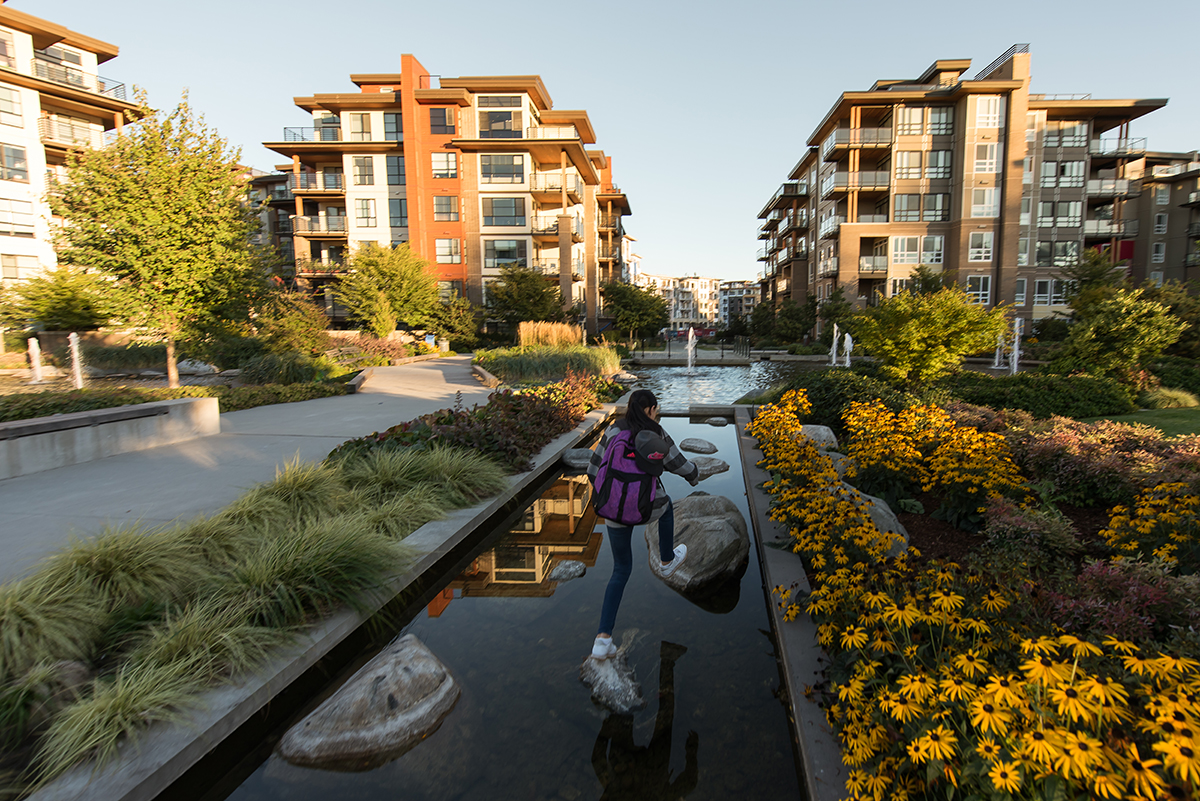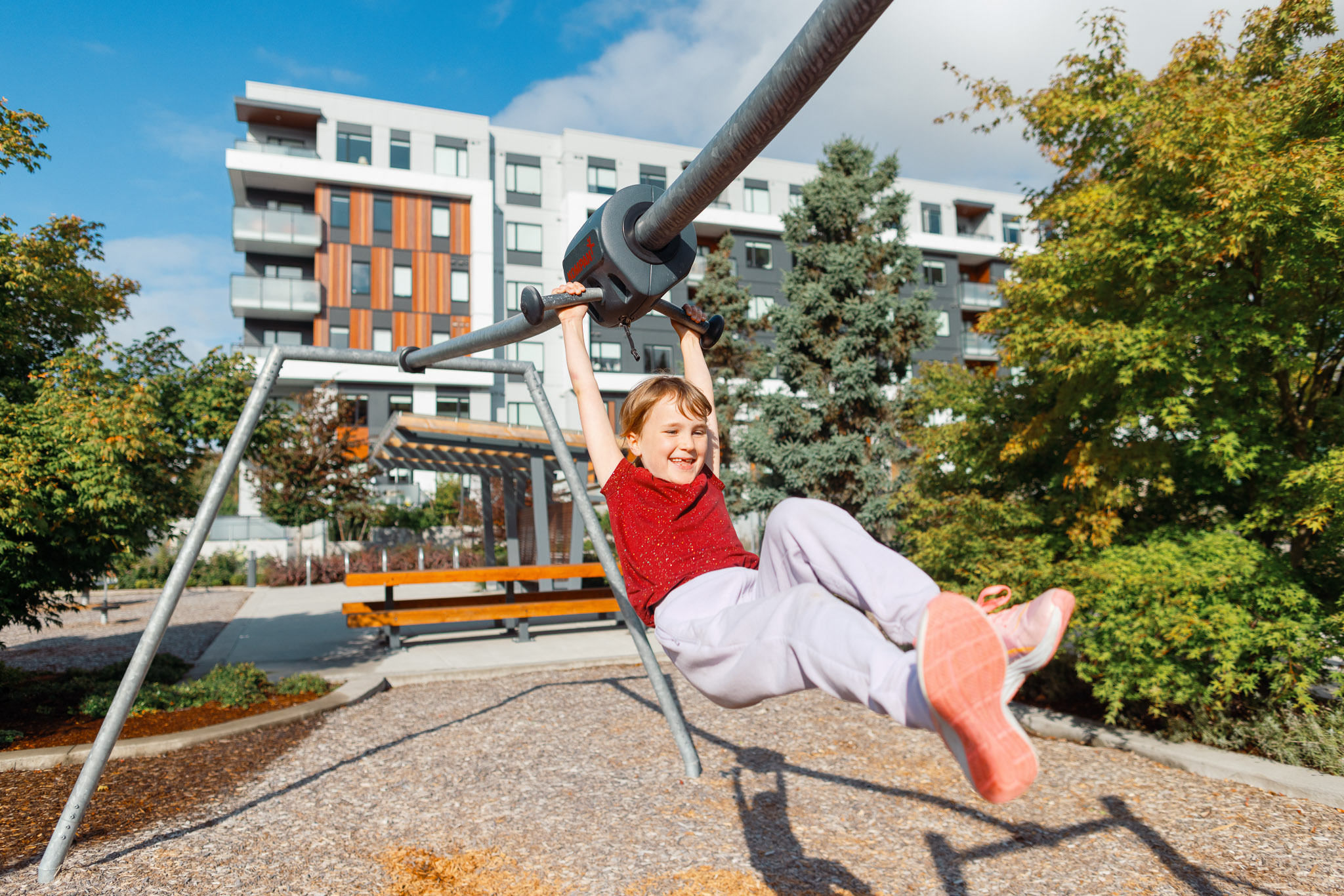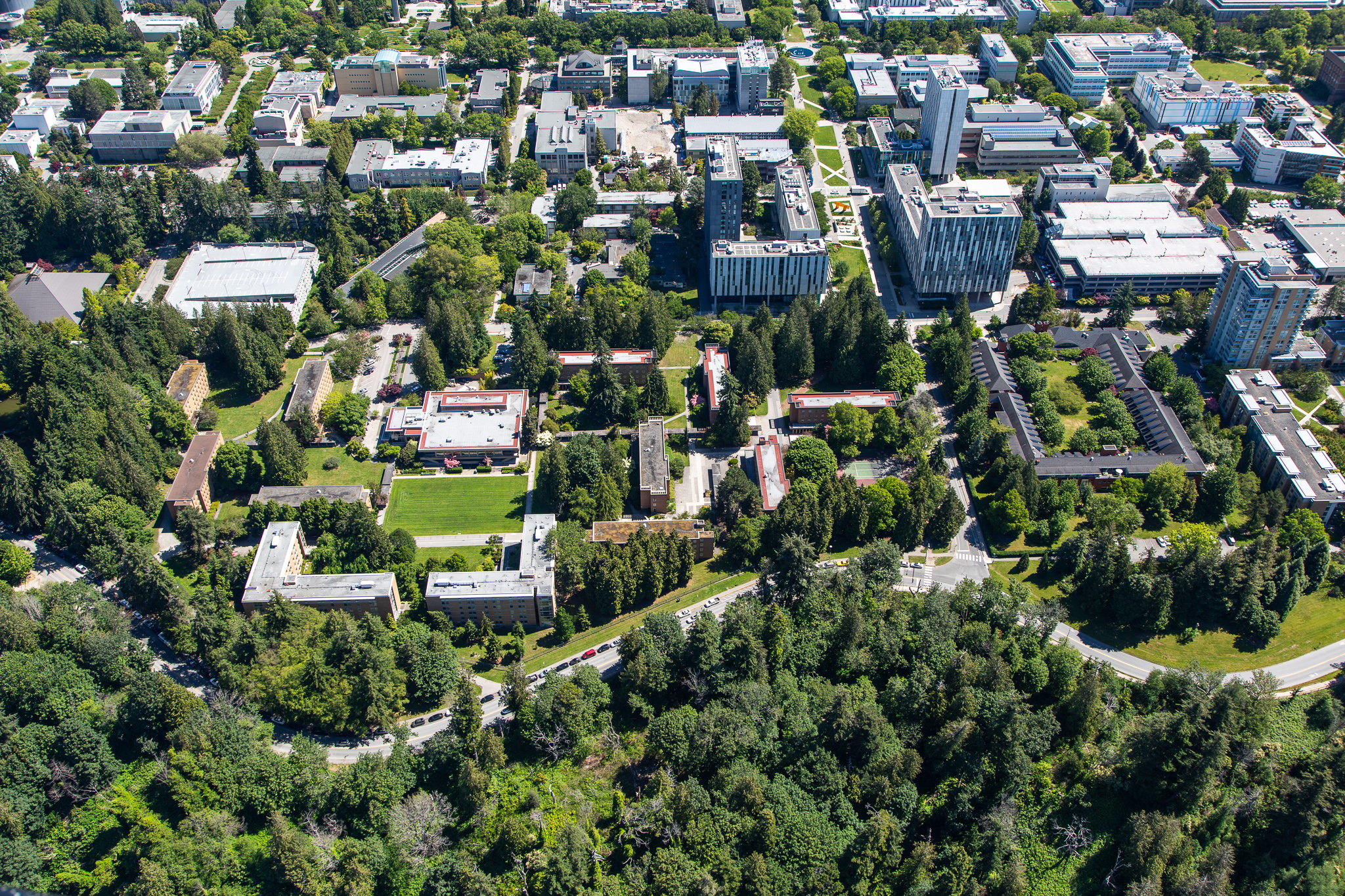Eagles’ Nest and Wesbrook Place Development
Note: This article has not been updated since March 27, 2023. For updated news, please visit our News page.
Click here to view Diamond Head Consulting Monitoring Memo March 2023
Click here to view Eagle Nest + Wesbrook Development Timeline
UBC Properties Trust has been implementing the Wesbrook Place Neighbourhood Plan, adopted in 2005. Wesbrook Place is one of six lively neighbourhoods with market housing on UBC Point Grey campus. The Trust came to be over 30 years ago when UBC was seen as a ‘commuter campus’, leaving the campus largely deserted in the summertime.
The Trust came to be over 30 years ago when UBC was seen as a ‘commuter campus’, leaving the campus largely deserted in the summertime. UBCPT leases “market housing” sites to developers on a 99-year basis, with all profits going back into the UBC endowment fund. To date, UBCPT has generated $2 billion for the endowment, which the university uses at its discretion, including to fund the construction of student housing in the campus core. Over the last 30 years, market rentals, staff and faculty rentals, communities with retail shops, grocery, and restaurants have transformed the campus to a vibrant community with over 15,000 residents. This could not have been achieved without the revenue earned and value created by UBC Properties Trust.
Over the past several years, new residences have been built in proximity to a bald eagle nest located within a stand of trees along Ross Drive. The nest had been apparently abandoned for some years and then nesting activity by a young eagle pair was observed in early 2017.
In 2017, UBCPT hired qualified and experienced biologists at Diamond Head Consulting to prepare a “Protected Species Management Plan” to prescribe the best construction practices that would minimize impacts to this nest. This consultant team monitored construction activities, noise levels and other potential disturbance factors during the construction of nearby Georgia Point and Oakwood. This nest has been occupied during nesting season annually throughout this construction activity and subsequent occupancy of these buildings in 2020.

The Provincial “Guidelines for Raptor Protection during Urban and Rural Land Development” identify bald eagles as a “not at risk” species with a “moderate to high” ability to coexist with human landscapes, and measures are prescribed to protect eagle nests from disturbance. UBCPT has been working with biologists from Diamond Head, project developers and contractors, provincial biologists, and a local non-profit organization (Hancock Wildlife Foundation) to determine how to best minimise impacts to nesting activity throughout construction and for future planned construction.
Despite reported attempts, the eagles at Wesbrook had been unsuccessful at breeding and rearing young between 2017-2021. A report by the Stanley Park Ecology Society (SPES) states nesting success in Vancouver is unpredictable with some breeding seasons seeing 100% success and others as low as 46%. 2022 is the first year the eagles were successful at breeding at least one eaglet. However, according to biologists at DHC, a lack of fledging activity, sounds, as well as a carcass found inside the nest suggest the eaglet died in sometime late June or early July, likely “due to natural causes as no construction was taking place and no vandalism to the nest was visible; however, the specific mechanism is uncertain due to the limited observations available from the bimonthly [every 2 weeks] monitoring. An avian flu is believed to have caused mortality at other nests in the Lower Mainland this summer. Other potential mechanisms could include lack of food, contaminated food, or weather-related mortality.”
A multi-residence development to the east of the nest is set to start construction in summer 2023 as well as an elementary school at a later time yet to be confirmed by the Vancouver School Board. It has been recommended by the raptor expert at the Ministry of Forests and David Hancock of the Hancock Wildlife Foundation, a recognized raptor expert with over 50 years experience, that the nest be temporarily closed during construction to mitigate impacts to the eagles. A permit to install the cone in the original nest was issued by the Ministry of Forests in early September 2022, and in order to precede the 2023 nesting season it needed to be in place in September before the eagles return to the region and start circling nest locations.
On September 14th, 2022, a temporary cone was placed on the original nest to redirect nesting activity during construction. Hancock has used this relocation method successfully in other locations, and the cone would be removed after construction is complete. UBCPT is continuing to engage with Diamond Head so that monitoring of the eagle activity is observed in the area while the cone is in place.
The Hancock Wildlife Foundation created an alternate nest in 2020 when construction was originally planned to commence. The location and composition of the nest was determined through experienced biologists’ meticulous assessment. During construction, the eagles could adopt the new nest or build their own.
For further enquiries please contact [email protected] or visit https://www.ubcproperties.com/news/
FAQs
The established eagle’s nest is located within proximity of future development sites: Lot 6 and the elementary school site. This construction activity could impact the eagle’s nesting activity—the coning aims to protect the established nest and redirect the nesting activity to a temporary alternate nest. The cone will be removed after construction is complete.
UBC Properties Trust is following recommendations by Diamond Head Consulting and Hancock Wildlife Foundation to cone this nest. Their advice is that it is the best option to protect nesting activity during future construction in the area. The Hancock Wildlife Foundation has successfully employed this technique locally and, along with the Provincial raptor experts and Diamond Head, have stated it is the best step.
As per the Neighbourhood Plan, Lot 6, adjacent to the established nesting tree, will accommodate much –needed housing for the UBC community and those wishing to live here. UBC Properties Trust’s mandate includes leasing sites to developers to create vibrant communities to work, live, and play. The development of this site with 231 units by Polygon Homes is part of the evolution of the campus into a more vibrant community.
UBC Properties Trust is committed to its sustainability value: put housing walkably close to work and study, while honouring the magnificent peninsula setting and topography of the landscape. This includes the environmental objective of providing the eagles the best chance possible at nesting in this area while completing the commitments to development.
Eagles fly north to Alaska for the salmon run from early August to mid-late September and can return to their nesting trees as early as mid-September. Eagles can become distressed if they see humans in and around their nest, so any work completed near the nest must be done before September 15. This date was provided to us by the Province. Construction is planned to start within the noise buffer of the established nest prior to August 2023; therefore, the nest needs to be coned. Cone installation before their return also maximizes the time available to the eagles to improve the temporary alternate nest or identify and build a new one.
If the eagles return before the cone is placed, encounter construction activities, and be subsequently scared off the nest while they are in the process of re-establishing for the 2022-2023 breeding season, it would likely cause complete and permanent abandonment of the original nest, effectively negating any efforts to protect the pair of eagles nesting in this area. UBCPT, the Province and the wildlife experts are not in favour of risking this occurrence.
The provincial biologist, Diamond Head Consulting biologists and representatives from Hancock Wildlife Foundation walked the area within 300m of the established nest tree to locate a suitable alternate location. The selected tree was chosen because of its moderate health and structure value, high retention value, location within 300m of the established nest and the presence of a crotch located 20m from the ground. This crotch provides an extensive enough area to accommodate a platform and provide access for the eagles. The alternate nest tree is located close enough for the eagle pair to find and access and is also located away from any other known eagle nests in the area. Adjacent to this tree, there are trees large enough for perching with clear sight lines.
Diamond Head Consulting submitted a permit application to the Ministry of Forests on June 30, 2022. The Province approved this permit on September 2nd, 2022. UBCPT had considered whether to install the cone this year, but it was clear that construction was scheduled to proceed on Lot 6 in 2023, therefore, to ensure we protect the established nest and the eagle’s nesting activities in this area, we followed recommendations from the wildlife experts and requirements by the Province to proceed to cone the established nest. The coning of the nest is to occur on September 14 as the deadline to install the cone is September 15 per the Province.
While we appreciate that this may be a preference, it has been thoughtfully considered that leaving the nest as-is is not in the best interests of the eagles. With construction due to commence in early 2023 coning the nest now was the only option to ensure the nest is protected and the nesting activity of the eagles continues in this area.
According to Diamond Head Consulting, nesting eagles are considered to be tolerant of human activity and have been shown to be resistant to noise disturbances as loud as 94 dBA.
>90 dBA construction activity was recommended to be avoided within the 160m noise buffer during nesting and breeding season.
Construction activity occurred outside the noise buffer in 2017. Construction occurred within the noise buffer in 2018-2020. During this time, a Qualified Environmental Professional (QEP) from Diamond Head Consulting (DHC) was onsite monitoring noise levels and eagle behaviour and had authority to order construction stoppage at the first signs of eagle disturbance. Polygon requested the presence of DHC when loud building work was scheduled to occur when constructing The Residences at Nobel Park to ensure there were no impacts to the eagles. According to reports, the eagles did not react to construction activities during this time, and have appeared to acclimatise to the noise, levels at which were determined to be under the recommended threshold.
Mating behaviours were observed in 2019, but the eagles were unsuccessful in breeding. According to the Stanley Park Ecology Society (SPES), nesting success in Vancouver is unpredictable with some breeding seasons seeing 100% success and others as low as 46%.
Continued monitoring for each breeding season was recommended by Diamond Head to observe potential impacts due to construction, and UBCPT is following through with this recommendation.
There has been no construction in the vicinity during the 2021 or 2022 breeding season.
No construction activity was carried out near or within the vegetation area nor the 160m sound buffer during the time of the eaglet’s passing. Stated in the report prepared by Diamond Head Consulting, “It is likely the mortality was due to natural causes as no construction was taking place and no vandalism to the nest was visible; however, the specific mechanism is uncertain due to the limited observations available from the biweekly monitoring. An avian flu is believed to have caused mortality at other nests in the Lower Mainland this summer. Other potential mechanisms could include lack of food, contaminated food, or weather-related mortality.”
While the proposed elementary school site is within the 160m sound buffer of the new nest, there are many unknown variables yet to be determined. The school board, in conjunction with the Province & Ministry of Education, determines the priority and timeline of planning, design, and building of schools. The permit for the cone on the original nest is in place until 2024 at which time the eagle’s behaviour will determine the best course of action.
Student housing is built in the institutional campus core, not in the neighbourhoods. Residential housing and supporting amenities are built in the neighbourhoods as per the Wesbrook Place Neighbourhood Plan, adopted in 2005, which can be found on the Campus & Community Planning website. All value created as a result of UBC Properties Trust activities is directed to the UBC endowment fund annually. These endowed funds can then be used at UBC’s discretion, including student housing initiatives. As a result, UBC has the largest number of student beds on campus in Canada.
In the 1980s, much of the vegetation in this area was cleared by UBC for research facilities. Since discovering the nest was active in 2017, the vegetation around the nesting tree has been retained. The adjacent lot lines of the development site, now Oakwood and Georgia Point, were adjusted to ensure the vegetation was retained.
The conservation specialists noted greater emphasis should be on the value of connected vegetated areas within the 60-meter vegetation buffer. Although lot 6 overlaps the 60m vegetation buffer on the southwest side of the lot, no connected vegetation is present due to the previous clearing of this area in the 1980s. There is no existing connected vegetation present on Lot 6 to be retained.
Given this, development on Lot 6 is proceeding as originally planned. The building should not adversely impact the eagle habitat long term as eagles are considered tolerant of human activity with a moderate to high ability to co-exist. However, it is necessary to mitigate the impact of construction noise in the short term to give the eagles the best chance of breeding success.
The aim of temporarily placing a cone on the original nest is to protect breeding activity by redirecting any eagles to the alternate nest or an existing nest in the area.
Timeline



